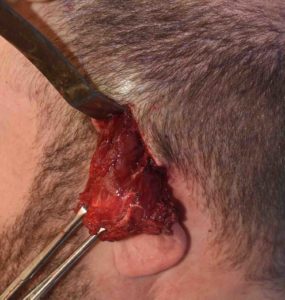The size of one’s head can be judged from different dimensions. One of these dimensions is head width, which is judged by the appearance or size of the head above the ears. A normal head width does not stand out and has either a flat to a very slightly convex shape. It lies well inside a vertical line drawn up from the superior arch of the ear. A narrow head width has a straight line or concave appearance between the superior temporal line and the ears.
Conversely, a wide head has a distinct convex shape that bows outward above the ears. Its width may equal the protrusion of the ear. In very large head widths the tissues may even make the top of the ear sticks out at its helical root attachment.
The side of the head is anatomically composed of bone, temporalis muscle and skin. It is structurally simple and there are no vital blood vessels or nerves in the area. What is often not appreciated is how much the temporalis muscle thickness contributes to the width of the head. Even though the posterior temporal muscle belly is far thinner than its anterior portion, it still has a thickness of 5 to 7mms. (if not more in most men)
Understanding the thickness of the posterior temporalis muscle serves as the basis of the temporal reduction procedure. Removing the entire thickness of the muscle can result in a very visible and distinct narrowing of the side of the head. In so doing there are no functional implications of jaw motion due to the remaining larger anterior muscle belly.

Dr. Barry Eppley
Indianapolis, Indiana


